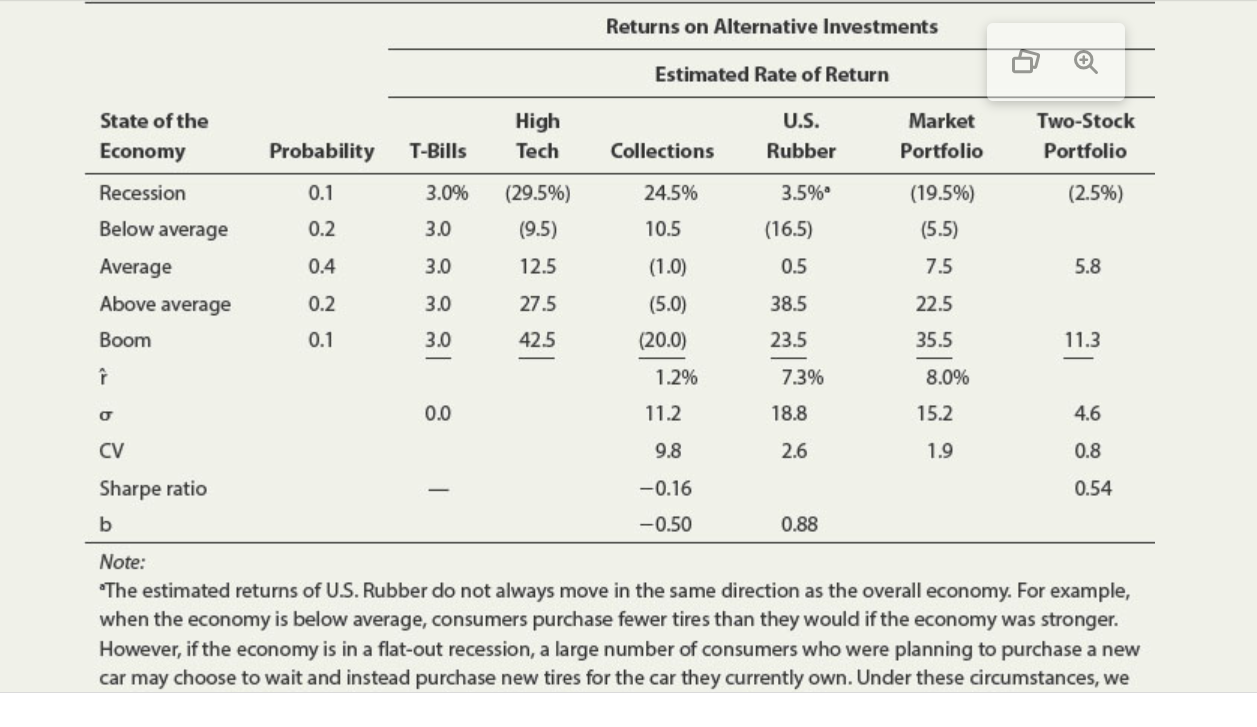Answered step by step
Verified Expert Solution
Question
1 Approved Answer
RISK AND RETURN Assume that you recently graduated with a major in finance. You just landed a job as a financial planner with Merrill Finch
RISK AND RETURN Assume that you recently graduated with a major in finance. You just landed a job as a financial planner with Merrill Finch Inc., a large financial services corporation. Your first assignment is to invest $ for a client. Because the funds are to be invested in a business at the end of year, you have been instructed to plan for a year holding period. Further, your boss has restricted you to the investment alternatives in the following table, shown with their probabilities and associated outcomes. For now, disregard the items at the bottom of the data; you will fill in the blanks later.
Merrill Finchs economic forecasting staff has developed probability estimates for the state of the economy, and its security analysts developed a sophisticated computer program to estimate the rate of return on each alternative under each state of the economy. High Tech Inc. is an electronics firm, Collections Inc. collects pastdue debts, and US Rubber manufactures tires and various other rubber and plastics products. Merrill Finch also maintains a market portfolio that owns a marketweighted fraction of all publicly traded stocks; you can invest in that portfolio and thus obtain average stock market results. Given the situation described, answer the following questions:
a
Why is the Tbills return independent of the state of the economy? Do Tbills promise a completely riskfree return? Explain.
Why are High Techs returns expected to move with the economy, whereas Collectionss are expected to move counter to the economy?
bCalculate the expected rate of return on each alternative, and fill in the blanks on the row for in the previous table.
cYou should recognize that basing a decision solely on expected returns is appropriate only for riskneutral individuals. Because your client, like most people, is riskaverse, the riskiness of each alternative is an important aspect of the decision. One possible measure of risk is the standard deviation of returns.
Calculate this value for each alternative and fill in the blank on the row for sigma in the table.
What type of risk is measured by the standard deviation?
Draw a graph that shows roughly the shape of the probability distributions for High Tech, US Rubber, and Tbills.
dSuppose you suddenly remembered that the coefficient of variation CV is generally regarded as being a better measure of standalone risk than the standard deviation when the alternatives being considered have widely differing expected returns. Calculate the missing CVs and fill in the blanks on the row for CV in the table. Does the CV produce the same risk rankings as the standard deviation? Explain.
eSomeone mentioned that you might also want to calculate the Sharpe ratio as a measure of standalone risk. Calculate the missing ratios and fill in the blanks on the row for the Sharpe ratio in the table. Briefly explain what the Sharpe ratio actually measures.
fSuppose you created a twostock portfolio by investing $ in High Tech and $ in Collections.
Calculate the expected return the standard deviation sigma p the coefficient of variation CVP and the Sharpe ratio for this portfolio, and fill in the appropriate blanks in the table.
How does the riskiness of this twostock portfolio compare with the riskiness of the individual stocks if they were held in isolation?
gSuppose an investor starts with a portfolio consisting of one randomly selected stock.
What would happen to the riskiness and to the expected return of the portfolio as more randomly selected stocks were added to the portfolio?
What is the implication for investors? Draw a graph of the two portfolios to illustrate your answer.
h
Should the effects of a portfolio impact the way investors think about the riskiness of individual stocks?
If you decided to hold a onestock portfolio and consequently were exposed to more risk than diversified investors could you expect to be compensated for all of your risk; that is could you earn a risk premium on the part of your risk that you could have eliminated by diversifying?

Step by Step Solution
There are 3 Steps involved in it
Step: 1

Get Instant Access to Expert-Tailored Solutions
See step-by-step solutions with expert insights and AI powered tools for academic success
Step: 2

Step: 3

Ace Your Homework with AI
Get the answers you need in no time with our AI-driven, step-by-step assistance
Get Started


